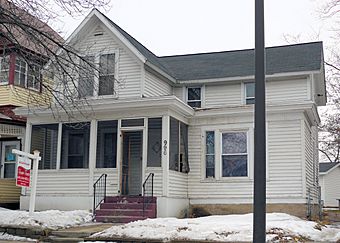S. Edward Hall House facts for kids
|
S. Edward Hall House
|
|
|
Formerly listed on the U.S. National Register of Historic Places
|
|
 |
|
| Location | 996 Iglehart Avenue Saint Paul, Minnesota |
|---|---|
| Built | 1906 |
| NRHP reference No. | 91000440 |
Quick facts for kids Significant dates |
|
| Added to NRHP | April 16, 1991 |
| Removed from NRHP | May 23, 2016 |
The S. Edward Hall House was a special home in Saint Paul, Minnesota. It belonged to S. Edward Hall (1878-1975). He was an African American businessman. He also started the Saint Paul chapter of the NAACP. This house was listed on the National Register of Historic Places from 1991 to 2016.
Contents
S. Edward Hall: A Community Leader
The S. Edward Hall House was important because of its owner, Stephen Edward Hall. He moved to St. Paul from Springfield, Illinois in 1900. He joined his brother, Orrie C. Hall, as a barber.
Starting a Business
By 1906, S. Edward Hall was married and had bought the house. The two brothers opened a barber shop. It was in the Germania Bank Building. At that time, many African Americans found good jobs as barbers. It was one of the few jobs where Black men could succeed. About one-fourth of barbers in St. Paul were Black men. It was the third most common job for Black men. Only porters and waiters had more jobs. Black barbers who served white customers could also earn more money. They could make important connections and gain influence.
Helping Others Find Jobs
S. Edward Hall used his connections to help other African Americans. When people needed work, Hall would ask his customers about job openings. A weekly newsletter called The Helper even mentioned his shop. This idea grew into a system. Other "tipsters" would tell "helpers" about job openings. The local African Methodist Episcopal church helped organize the Helper Movement. Hall was its vice president.
This job referral system did not solve all job shortages. It also did not help much for jobs outside of service work. In 1923, Ed Hall helped start the St. Paul branch of the National Urban League. This group offered more support for people looking for jobs. It also received donations from the Community Chest. Hall stayed active with the Urban League for many years. When he passed away in 1975, he was an honorary board member. He was also President Emeritus of the group. Hall kept helping people find jobs through his barber shop. For example, he helped the Ford Twin Cities Assembly Plant hire more Black employees in 1925.
Building Community Support
S. Edward Hall wanted to help African Americans find jobs. But he also wanted to help them connect with each other. He also wanted to help them adjust to city life. In 1908, Hall worked with the Mars Lodge of the Oddfellows. They helped create Union Hall, which opened in 1914.
Later, around 1928, the Black branch of the YWCA on Central Avenue closed. The Urban League saw a need for a community center. This center would offer education, social help, and fun activities. The Great Depression was also making life harder for African Americans. Ed Hall helped move the Central Avenue YMCA location. It became the Hallie Q. Brown Center. This center became its own group, separate from the Urban League, in 1930.
By 1934, many people in Ramsey County, Minnesota needed help. In the neighborhood around the center, nine out of ten people needed relief. Jobs for African Americans were hard to find. Railroads and packing plants had laid off many workers. The Hallie Q. Brown Center offered nursery services for children. This helped mothers who were looking for service jobs. S. Edward Hall was a member of the Center his whole life. He was also a President Emeritus when he died.
What Happened to the House?
The S. Edward Hall House was torn down in June 2011. There was a mistake at the Minnesota Historical Preservation Office. They did not realize the house was on the National Register of Historic Places before it was demolished. The house was officially removed from the list in May 2016.



